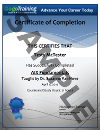Course Description
This Service Transition (ST) course provides you with an intense and focused exploration of the new and modified topics in ITIL® 2011. The course is intended for those who work within a Service Transition environment and require a deeper understanding of the underlying concepts, processes and activities involved and associated management responsibilities and how they may be used to enhance overall service quality and service provision. The course focuses on the managerial and control aspects of the operational environment. It has a number of study units and supporting exercises that reinforce the knowledge gained.
When PeopleCert offered this exam in English, this course received PeopleCert Accredidation. However, PeopleCert no longer offers this exam in English and therefore GogoTraining no longer pays PeopleCert to list this course as an accredited course. If you are looking to understand ITIL V3 Release, Control & Validation, then this course is a great place to start.
In This Course You Will Learn:
- Discuss the Service Lifecycle and Service Management as a Practice: Understand the Service Lifecycle and the objectives and business value for each phase in the lifecycle; understand and articulate “service” and be able to explain the concept of Service Management as a practice
- Identify basic Service Transition Principles: Understand the common principles and guidelines that will influence the performance of ST processes with a concentrated focus on managing the plan, build, test and implementation activities
- Explain Service Design Processes: Understand the managerial and supervisory aspects of the ST processes. Other areas of discussion include the roles and responsibilities, challenges, critical success factors and risks within each of the processes. The processes include:
- Transition Planning and Support
- Change Management
- Service Asset and Configuration Management
- Release and Deployment Management
- Service Validation and Testing
- Change Evaluation
- Knowledge Management
- Organize Service Transition: Understand the role and the responsibilities of each of the activities and their input to all lifecycle phases; managing people through the transition activities; improving the transition activities
- Explore Technology and Implementation Considerations: Understand the role of technology to Service Transition and explore concepts that have great impact on ST process implementation
Prerequisites
ITIL® Foundations is recommended prior to learning abount Service Transition. Getting the ITIL Service Lifecycle core publications and, in particular, the ITIL Service Transition publication is highly recommended.
Outline
Module 00: Course Introduction
Module 01: Exam Tips
Module 02: Service Management as a Practice Part 1
- Components of the Service Lifecycle
- What is a Service?
- What Comprises Value?
- What is Service Management?
- A Process
- Generic Roles
Module 03: Service Management as a Practice Part 2
- Purpose & Objectives of Service Transition
- Scope of Service Transition
- Value to the Business
- ST Inputs & Outputs
- ST Challenges, Risks, CSFs
- Key Concepts for Service Transition
Module 04: Exercise: ITSM and Failure
Module 05: Service Transition (ST) Policies
- Review
- Policies for Service Transition
Module 06: Managing ST
- Managing Difficult Situations
- Optimizing ST Performance
- Technology Specific to Service Transition
- Exercise: Writing Policy Statements
Module 07: Transition Planning & Support (TPS) Part 1
- Overview
- Purpose & Objectives
- Value to the Business
- Policies/Principles/Basic Concepts
- Process Overview
Module 08: Transition Planning & Support (TPS) Part 2
- Triggers, Inputs/Outputs & Interfaces
- Metrics
- Challenges & Risks
- Process Roles
Module 09: Change Management (ChM) Part 1
- Purpose & Objectives
- Value to the Business
- Policies/Principles/Basic Concepts
Module 10: Change Management (ChM) Part 2
- Process Overview
- Triggers, Inputs/Outputs & Interfaces
- Common Metrics
- Challenges & Risk
- Process Roles
Module 11: Service Asset & Configuration Management (SACM) Part 1
- Purpose & Objectives
- Value to the Business
- Policies/Principles/Basic Concepts
Module 12: Service Asset & Configuration Management (SACM) Part 2
- Process Overview
- Triggers, Inputs/Outputs & Interfaces
- Metrics
- Challenges & Risks
- Process Roles
Module 13: Release & Deployment Management (RDM) Part 1
- Purpose & Objectives
- Value to the Business
- Policies/Principles/Basic Concepts
Module 14: Release & Deployment Management (RDM) Part 2
- Process Overview
- Triggers, Inputs/Outputs & Interfaces
- Metrics
- Challenges & Risks
- Process Roles
- Exercise: Early Life Support Criteria
Module 15: Service Validation & Testing (SVT) Purpose and Objectives
- Purpose & Objectives
- Value to the Business
- Policies/Principles/Basic Concepts
Module 16: SVT Testing
- Test strategy
- Test model
- Types of Testing
Module 17: SVT Process
- Process Activities
- Triggers, Inputs/Outputs & Interfaces
- Metrics
- Challenges & Risks
- Process Roles
Module 18: Change Evaluation (ChE)
- Purpose & Objectives
- Value to the Business
- Policies/Principles/Basic Concepts
- Process Overview
- Triggers, Inputs/Outputs & Interfaces
- Metrics
- Challenges & Risks
- Process Roles
Module 19: Knowledge Management (KM)
- Purpose & Objectives
- Value to the Business
- Policies/Principles/Basic Concepts
- Process Overview
- Triggers, Inputs/Outputs & Interfaces
- Metrics
- Challenges & Risks
- Process Roles
Module 20: Managing People through Service Transitions Part 1
- Managing Communication
- Organizational & Stakeholder Change
- STs Role in Organizational Change
Module 21: Managing People through Service Transitions Part 2
- Assessing Organizational Readiness
- How to deal with Change
- Stakeholder Management
Module 22: Organizing, Implementing & Improving Service Transition
- Organizing for Transition
- Generic ST Roles
- ST Relationship with Lifecycle Phases
- Implementing Service Transition
- Summary
How can we help? Customer Service is standing by to answer your questions.


